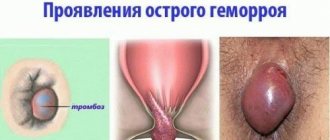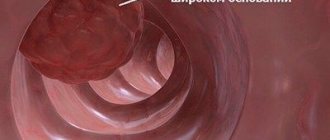Intestinal polyps are benign formations that rise above the mucous membrane and protrude into the intestinal lumen. This pathology is one of the most common among diseases of the digestive system. The colon is most often affected by polyps; in 70% of cases they are located in the terminal sections of the large intestine: (sigmoid, descending, rectum). By the way, rectal polyps are perhaps the most numerous. Much less often, pathological formations appear in the small intestine. Men are more likely to suffer from this disease; the main category of patients is people over 50 years of age, although there are types of polyps that are diagnosed in young patients and even children.
There are many varieties of polyps, differing in morphology, size, shape; they can reach several centimeters, be single or located in groups. Some of them are easily injured, which leads to bleeding, some are capable of reaching large sizes, blocking the lumen of the intestine, others are prone to ulceration, and there are forms that are dangerous due to their ability to degenerate into a cancerous tumor. By the way, there is a relationship between the size of the polyp and the likelihood of turning into cancer: if intestinal polyps, the size of which does not exceed 1 cm, degenerate in only 1%, then formations larger than 2 cm become malignant in 45%.
The exact causes of the appearance of polyps still cause disagreement among specialists. It is assumed that the cause may be an inflammatory process in the intestines associated with infection, indigestion, stagnation of feces, and bad habits. Also unfavorable factors are the presence of diverticula, physical inactivity and even diet: lack of fiber in food or excess of fats and carbohydrates. In addition, the cause of the development of polyps may be a hereditary predisposition; as an example, we can mention polyposis - multiple lesions of the gastrointestinal tract. This disease occurs among close relatives.
Risk group:
- the presence of chronic diseases of the gastrointestinal tract;
- abuse of products that irritate the intestinal mucosa;
- previous intestinal injuries;
- the presence of patients among close relatives;
Symptoms:
- digestive disorders: constipation, diarrhea, flatulence;
- abdominal pain or intestinal discomfort;
- mucus or blood in stool;
- sensation of a foreign body, prolapse - characteristic of a polyp in the rectum;
Polyps in the intestines: general information
Polyps affect the gastric mucosa.
Polyps are a pathology of soft tissues where they grow. Unlike skin growths (warts, plaques), a polyp has a thin stalk, which can reach 1–2 mm.
Polyps affect only the mucous membranes, so tissue growth can be seen in the nose, stomach or colon. Distinctive features:
- Polyps often form on the lining of the colon.
- They are fleshy in structure, have nerve endings and a circulatory system. In some cases, they may have a spherical or mushroom shape, a reddish tint with gray spots. Upon examination, mucus may be found on the surface.
- There are three types of polyps: inflammatory, neoplastic and hyperplastic.
- Appears in 15% of people aged 45–50 years and above. The overgrown tissue can be either single or multiple. Sometimes diffuse polyps (familial) are distinguished, originating from one leg.
- Polyps can be benign or malignant. It all depends on the type of tissue and histological structure.
- They are divided into villous, glandular, juvenile, fibrous and hyperplastic growths. The anomaly is practically asymptomatic in 80% of cases. Often, all the symptoms of an intestinal polyp are discovered by chance.
- The process of polyp development begins with one healthy cell, which is affected by regular inflammatory processes. For this reason, cells are unable to divide evenly, forming small local growths. Polyps tend to grow and proliferate. First, small growths appear, reaching 2–3 mm in diameter, and then they increase to several centimeters.
Reaching its maximum size, the growth can damage the intestinal wall as it grows in the lumens, which leads to bleeding.
Tinctures and decoctions
Tinctures and decoctions do an excellent job of treating polyps in the early stages of development. The most popular means are:
- Tincture of freshly ground celandine mass. An infusion of 500 ml of vodka and a glass of the mixture is prepared within three weeks. To take two drops of the infusion, mix it in 50 ml of water and take it in the morning, increasing the concentration by two drops daily, bringing the maximum amount to 16.
- A decoction of fresh celandine leaves. Two spoons of the plant are poured with half a liter of boiling water and simmered in a water bath for half an hour. The product works well when giving an enema. A week after the seven-day course, the treatment is repeated,
- Decoction of burdock leaves. Prepared according to a scheme similar to that used for making decoctions of celandine, take one teaspoon twice a day. After two weeks of use, you should take a two-week break.
Read also: Signs of colitis in a child, how to recognize and treat intestinal disease in time
Reasons for appearance
Polyps in the intestines can be inherited.
The main reason is hereditary predisposition. Previously, a colonoscopy (a medical examination of the colon) was prescribed only if someone in the immediate family suffered from colon cancer.
It is a proven fact that any change in the development of mucosal cells depends on hereditary factors. Other causes of pathology:
- Poor nutrition. If the diet includes a large amount of animal fats, then this has a detrimental effect on the condition of the entire digestive tract. Fecal masses are formed due to fiber, which is absent in animal fats. Because of this, intestinal perilstatics decrease, the process of defecation becomes difficult, and regular constipation appears. It is recommended to reduce the consumption of meat and fatty dairy products, as well as white flour, smoked meat, margarine, soda water, and sugar. Stagnation of feces injures the delicate walls of the intestine, which leads to the appearance and localization of polyps.
- Inflammatory processes. Chronic inflammation of the mucous membrane leads to aging and death of epithelial cells. Instead, pathogenic growths grow. The main cause of inflammation is diseases of the abdominal cavity and digestive system. For example, dysentery, enteritis, typhoid fever, ulcerative colitis.
- Abdominal vascular pathology. Polyps develop against the background of varicose veins, atherosclerosis of the peritoneal aorta, thrombosis and ischemia.
- Cell aging. The main reason is age-related changes in the body. Cells undergo natural aging and, closer to 50 years, pathogenic growths develop, and the formation of the intestinal mucosa is disrupted. The aging process is accelerated by poor nutrition, alcohol consumption, smoking, and the environmental situation of the city.
Enemas and microenemas
If the patient does not suffer from warthog intolerance, then enemas with its juice will have a beneficial healing effect. Both enemas with the juice of a plant, also called celandine, and with a decoction of warthog help well. In the first case, the duration of treatment is quite long - 3 courses of 15 days, after each course a two-week break should be taken.
Enema
The second method of treating intestinal polyps with a folk remedy is simpler, but its duration is even longer. Treatment can last up to six months. Preparation of the decoction involves infusion of 1 tablespoon of celandine with 0.25 liters of liquid in a water bath.
Symptoms
Polyps in the intestines can cause bleeding from the anus.
In many cases, tumors are discovered accidentally during a colonoscopy, and the symptoms of an intestinal polyp may not be pronounced.
- Bleeding from the anus. Patients often confuse this symptom with anal fissures, hemorrhoids and fistula. As a rule, bleeding is accompanied by a large amount of mucus.
- Regular constipation. Feces pass on their own, but rarely and painfully, or with the help of enemas or laxatives.
- Painful sensations. Large polyps cause cramping pain in the intestinal area (in some cases confused with flatulence). Painful sensations may also appear in the lower abdomen.
- Foreign body sensation. The feeling occurs in the rectum near the anus.
- Diarrhea. Frequent bowel movements with loose stools. Blood, pus, and serous discharge may be present.
- Damage. Constipation causes an inflammatory process where solid stool damages the intestinal walls. Anal fissures often appear, which must be treated with antiseptics and anti-inflammatory drugs. If this is not done, purulent fistulas may form.
- Exhaustion. Polyps are soft tissue that grows due to nutrition. It enters through the circulatory system and lymphatic currents. The patient often experiences an increase in appetite, or, conversely, a decrease. Symptoms of anemia may be present: pale skin, circles under the eyes, dizziness, nausea, headaches. In some cases, anemia is a clinical symptom.
- Dropping out. If the tumor is located in the rectum, it may fall out during defecation, or block the passage of feces near the sphincter. This symptom is also accompanied by bleeding.
Treatment with celandine
There are a lot of treatment methods using celandine. The choice should be based on tolerance to the plant sap, which can irritate mucous membranes with open wounds.
- Enemas with celandine. The course of treatment consists of three procedures. The first is to administer an enema with celandine juice in a concentration of 1 tsp. per liter of water. Duration of treatment – 15 days. The second procedure is carried out after a two-week break. The composition of the solution should not be changed, only the amount of celandine now needs to be increased to 1 tablespoon. The duration of therapy is 15 days, then again you need to take a break of 2 weeks. At the third stage, you should again do enemas for 15 days, the composition of which is completely the same as that in stage 2. In most cases, after such treatment, polyps in the large intestine disappear. If necessary, the course can be repeated after 4 months.
Read also: Possible causes of diarrhea in a nursing mother, complications, first aid, methods of therapy and diagnosis
Celandine
- Microenema with infusion of celandine. The method is recognized as gentle and the simplest of all recipes in which celandine is the main active ingredient. The disadvantage of this method is the long duration of therapy, sometimes reaching 6 months. To prepare the infusion, add a teaspoon of the dried plant to a glass of water and cook in a water bath for 30 minutes, then strain and leave to infuse for half an hour. Enemas should be done daily; after a ten-day course, a break of 3-4 days is necessary, after which the procedure is repeated.
- Taking a decoction of celandine orally. A tablespoon of herb is poured into half a liter of boiling water and infused for 60 minutes. The resulting composition should be drunk in several doses over 3 days. To cure, you should take the remedy half an hour before breakfast, lunch or dinner. The duration of treatment is 1.5-2 months, after which it is necessary to take a break for 100-120 days.
- Alcohol infusion of celandine. To prepare it, you need to stock up on a bottle of vodka, to which you should add the leaves and roots of celandine. All this must be infused for 25 days. The infusion should be taken starting with a few drops, gradually increasing the dose.
Celandine is a unique natural remedy, rich in essential oils and organic acids. In the initial stages of tumor development, it copes well with treatment, and in more severe cases, it significantly slows down tumor growth.
Additional verification methods
Surgery will help get rid of polyps.
If rectal polyps are suspected, a digital examination is performed.
This method helps to determine the presence of neoplasms in the rectum and anal canal at a distance of 10 cm. It is also possible to identify the structure of the polyp, their number, stalk length and displacement.
Sigmoidoscopy is used, which includes visual diagnostics. A device, a sigmoidoscope, is inserted into the rectum, after which the proctologist examines the condition of the mucous membrane. X-ray examination of the intestines and stomach.
Prescribed together to identify the number of polyps, find out their structure, determine the length and affected area. Diagnosis is carried out using irrigoscopy (the use of a contrast agent in an X-ray examination). In some cases, endoscopy is prescribed. A device similar to a colonoscope, but only inserted orally.
If a polyp is detected, it is necessary to collect biomaterial and undergo analysis for histology and cytology.
Effective recipes
You can help the body cope with polyps through proven recipes. The following recipes have worked well:
- Viburnum tea. Using the product in the amount of five glasses during the day helps prevent the appearance of tumors in the intestines. Viburnum also has a slight absorbable effect, so at an early stage of polyp development it helps to get rid of it.
Kalina
- Products based on pine and pine needles. Being a real storehouse of phytoncides and bioflavonoids, they prevent the development of infectious processes and have an antiseptic effect. By using these substances, it is possible to prevent the degeneration of a benign tumor into a malignant one. To prepare the healing composition, you need to pour one teaspoon of pine needles with a liter of water, the temperature of which is 95-100 degrees. After boiling the needles for 20 minutes, the mixture should be poured into a thermos and left for 4 hours. The dosage regimen is simple: 100 milliliters on an empty stomach in the morning for one month. After a break, the course can be repeated.
Traditional medicine traditionally uses certain plants that are effective in combating specific diseases. One such remedy that helps remove a polyp is celandine, which has an antibacterial and restorative effect.
Preventive actions
To prevent the occurrence of nasal polyposis and paranasal sinuses, it is recommended to prevent this condition: Treat infectious diseases in a timely manner. If nasal breathing problems occur, immediately contact an otolaryngologist. If bronchial asthma develops, be constantly monitored by an otolaryngologist and an allergist. Prevent relapses of surgical treatment. For this purpose, irrigation therapy and conservative treatment are used. Nasal polyposis is a fairly common disease that leads to chronic impairment of nasal breathing, which significantly reduces the quality of life of adults and children. To get rid of this problem, you need to promptly consult a doctor who will make a diagnosis and select effective treatment. Typically, surgery helps eliminate the symptoms of polyposis, and postoperative monitoring and therapy help prevent relapses of the disease.
Fresh juices
Celandine juice can be used not only for preparing decoctions and infusions for enemas. It perfectly helps reduce inflammation when used internally. The essence of the method is to get the plant juice onto the polyp. Strained warthog juice should be diluted with vodka in a 1:1 ratio. The product must be taken on an empty stomach 3 times a day. Possible use in diluted form. The duration of the course of therapy is 10 days.
Fresh juices
An excellent remedy for eliminating polyps is freshly squeezed juices of vegetables such as carrots, pumpkin, and beets. They have been used to combat such pathology for many years. Take one glass of juice five times a day before meals. With the systematic use of drinks, the process of resorption of polyps will be accelerated. Chicken egg yolk, ground with pumpkin seeds and taken on an empty stomach for a week, is also effective.










